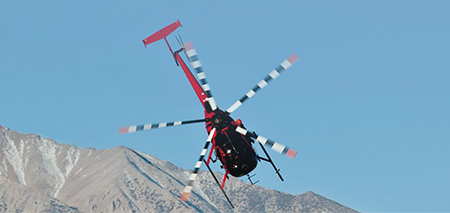 A busy chief engineer, pulled in too many directions, with too many interruptions, experiences the inevitable.
A busy chief engineer, pulled in too many directions, with too many interruptions, experiences the inevitable.
At the end of an October 2020 early morning spray run, a South Island helicopter pilot was returning to the load site, when the aircraft’s GPS system suddenly lost reception.
After landing, the pilot walked around the aircraft. He found the panel holding the GPS antenna on the horizontal stabiliser was attached by only a single coax cable, connected to a VHF comm antenna on the same panel. All the panel screws were missing.
The pilot called the chief engineer, who’d released the aircraft to service. During the phone call, the chief engineer realised he’d been responsible for the incident.
“The aircraft had been in for scheduled maintenance, and I’d had one last job to do on it. It was a busy morning, with several aircraft being released to service.
“I was chief engineer, job manager, and on the tools. My phone was ringing constantly. I was overseeing a couple of aircraft on check, there were a couple of other problems I needed to deal with, and I was working on the machine the panel needed to go on.
“I climbed the ladder to fit the panel but only finger-tightened the screws, because – probably because of the busyness, even stress, of that morning – I’d broken my own rule in not having a screwdriver always with me, so I got down off the ladder to get one.
“That’s when my phone rang, and I broke another rule by answering it in the middle of a job. After the call finished, instead of returning directly to the job, I went and dealt with the problem the call had been about.
“Only then did I return to the aircraft, but it had, by then, been moved outside for ground running – the other engineers clearly thought I was done with it and it was ready for release to service.
“Forgetting totally about my final task of screwing down the panel on the horizontal stabiliser, and preoccupied with all my other responsibilities that morning, I took a final walk around. I could see the VHF comm antenna, so assumed everything was okay.
“The next morning, the pilot called…”
Solutions from the workshop, the psychologist, and the CAA
The workshop – a change of policy and procedure

Photo: iStock.com/sierrarat
The company did a root cause analysis of the incident, and it wasn’t long before they realised the chief engineer’s distraction was a symptom, not the source, of the problem.
“I was dealing with too much stuff,” he says. “Our investigation found I didn’t really have a proper support person to share the workload, to answer clients’ questions, troubleshoot, and do research.
“So, we hired a couple more engineers and I was able to reduce my workload. I still work on some jobs but am now no longer job manager.
“I leave incoming calls while working on a job, then ring people back, rather than answer my phone straight away. And the company encourages clients to call the office line and use engineers’ mobile phones only in emergencies.”
And in a brilliantly simple move, the organisation reshuffled desks so the chief engineer wasn’t the first point of contact when people entered the building, to avoid even further distractions and workload.
“I also now practise ‘go back five steps’, the engineer says. “Each time I’m interrupted then resume the job, I go back five stages in the work to make sure it’s all been done, up to the point of the interruption.”
The psychologist – we’re hardwired for distraction
Keith McGregor is an organisational psychologist with an aviation background, and experience as a transport accident investigation consultant.
He says our brains are designed to be distracted.
“Back in the day, that rustle in the bushes may have represented a threat. Our subconscious mind was constantly monitoring the environment for potential threats.
“But while distraction may have once been a survival asset, when it occurs in a present-day complex technical setting such as flying, it can, ironically, be our killer.”
Prospective memory
Keith says that almost everything we do, day-to-day, involves remembering to carry out specific actions at some point in the future.
“That’s ‘prospective memory’ and the challenge with it, is that there are no cues to activate it. We have to ‘remember to remember’. So we use engineered devices – flight strips, seat-belt warnings, or automated verbal warnings – to remind us to take action.
“But in spite of tools like these, prospective memory can still fail. A NASA report1 has noted that, in five of the 27 major US airline accidents between 1987 and 2001 – where crew error was found to be a causal factor – inadvertently leaving out a step in a normal procedure played a crucial part.”
Studies indicate that the quality of our prospective memory relies on the capacity of our working memory – our ability to retain the list of actions we need to carry out and when to carry them out. That varies from person to person.
“But working memory capacity, no matter how good it is normally,” says Keith, “can be reduced if you’re stressed, fatigued, anxious, ill, or preoccupied.”
The fallacy of multitasking
Keith also notes that the belief that humans can multitask adds to the risks because it’s untrue.
“If both tasks need deliberate thought, we switch back and forth between them.”
The switch may be as fast as a 10th of a second, so we think we’re equally focussed on two, or more, tasks.
But in fact, at any point, we’re actually not monitoring at least one of them at all.
“Hence the shock of looking up from changing the car radio station, to realise the car 10 metres ahead has completely stopped,” says Keith.
What to do
Keith says we cannot stop being distracted – we’re simply not wired that way – but we can implement strategies that might help.
“The chief engineer at the centre of the story has some really useful suggestions. But it would also be interesting, if, before popping back to get his screwdriver, he’d tied a handkerchief around the end of the antenna he was working on. Using spontaneous, hard-to-miss cues can help signal that an action is incomplete.”
Keith says we are generally aware when we’ve been distracted.
“A simple technique to help us make sure we return to the original task is to consciously name the distraction. Actually say out loud, ‘This is a distraction’.”
Another strategy is ‘deliberate action’2. This means that before taking any action, a worker pauses, gestures, and states what they’re about to do – even if they’re alone.
It’s injecting a moment of mindful thinking between the impulse to do something and the actual physical act of making it happen.
Since learning about deliberate action, Keith says that when leaving his office, he verbally states to himself, “I’ve set the alarm. I’ve locked the door”. He says this has put an end to the frustration of getting halfway home and suddenly thinking, “Did I set the alarm?”.
“This process helps because it activates a wider range of brain functions which strengthens the likelihood I’ll remember what I did, in a timely way,” he says.
The CAA – making full use of the worksheet
CAA Chief Advisor of Airworthiness Warren Hadfield advocates for making the fullest possible use of worksheets.
“Following sound processes such as keeping an up-to-date record of maintenance carried out is paramount,” he says.
This is what Advisory Circular AC43-1 Aircraft maintenance3 says about keeping worksheets up-to-date so they accurately reflect where the maintenance of the aircraft is at:
“Various accidents have been attributed to incomplete maintenance where maintenance providers have initiated a maintenance action without making a record in an appropriate document.
“Accurate work records assist the certifying engineer (“In fact, they help all engineers working on the aircraft”, says Warren) in ensuring that all necessary maintenance, including work arising during the check, is complete and that the aircraft is in an airworthy condition prior to release to service.
“They also support the operator in making an assessment that all necessary maintenance has been completed prior to returning the aircraft to operation.”
1 Concurrent task management and prospective memory: pilot error as a model for the vulnerability of experts, NASA Ames Research Center, 2006.
2 Turn the ship around, David Marquet, 2013.
3 Subpart B – Maintenance, 2.16, 43.69(b) Associated Worksheet.
